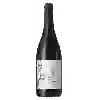
Winery Jeff CarrelPoint de Vue
This wine is a blend of 2 varietals which are the Chardonnay and the Riesling.
This wine generally goes well with pork, vegetarian or poultry.
Food and wine pairings with Point de Vue
Pairings that work perfectly with Point de Vue
Original food and wine pairings with Point de Vue
The Point de Vue of Winery Jeff Carrel matches generally quite well with dishes of pork, rich fish (salmon, tuna etc) or spicy food such as recipes of savoyard pizza (cream base), skate wings with black butter sauce or tunisian tagine.
Details and technical informations about Winery Jeff Carrel's Point de Vue.
Discover the grape variety: Chardonnay
The white Chardonnay is a grape variety that originated in France (Burgundy). It produces a variety of grape specially used for wine making. It is rare to find this grape to eat on our tables. This variety of grape is characterized by small bunches, and small grapes. White Chardonnay can be found in many vineyards: South West, Burgundy, Jura, Languedoc & Roussillon, Cognac, Bordeaux, Beaujolais, Savoie & Bugey, Loire Valley, Champagne, Rhone Valley, Armagnac, Lorraine, Alsace, Provence & Corsica.
Last vintages of this wine
The best vintages of Point de Vue from Winery Jeff Carrel are 2017
Informations about the Winery Jeff Carrel
The Winery Jeff Carrel is one of of the world's great estates. It offers 91 wines for sale in the of Vin de Pays to come and discover on site or to buy online.
The wine region of Vin de Pays
Vin de Pays (VDP), the French national equivalent of PGI (Protected Geographical Indication) at the European level, is a quality category of French wines, positioned between Vin de Table (VDT) and Appellation d'Origine Contrôlée (AOC). This layer of the French appellation system was initially introduced in September 1968 by the INAO, the official appellation authority. It underwent several early revisions in the 1970s, followed by substantial changes in September 2000 and again in 2009, when all existing VDT titles were automatically registered with the European Union as PGI. Producers retain the choice of using either the VDP or PGI titles on their labels, or both - in the form "IGP-Vin de Pays".
The wine region of Pays d'Oc
Pays d'Oc is the PGI for red, white and rosé wines that are produced over a wide area of the southern coast of France. The PGI catchment area corresponds roughly to the Languedoc-roussillon">Languedoc-Roussillon wine region, one of the largest wine regions in France. The area covers all wines that are not produced under the strict laws that govern AOC-level appellations in the regions: among them, Corbières, Minervois and the Languedoc appellation itself. The Pays d'Oc PGI is arguably the most important in France, producing the majority of the country's PGI wines.
The word of the wine: Vaccaresis
Black grape variety, one of the 13 of Châteauneuf-du-Pape, which can be used in a blend in this appellation and other neighbouring AOCs (Côtes-du-Rhône, Gigondas...). It produces a floral, elegant and fresh wine, which balances the warmth of the Grenache. It is rare.














